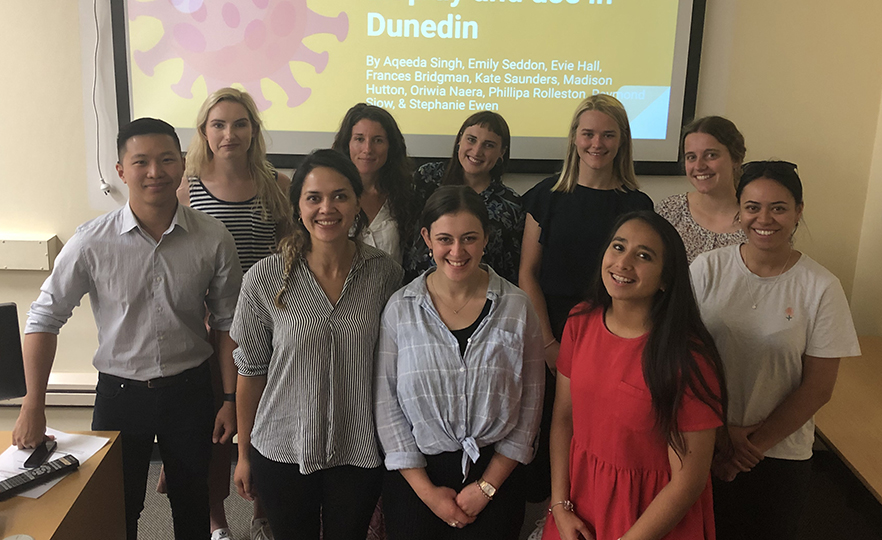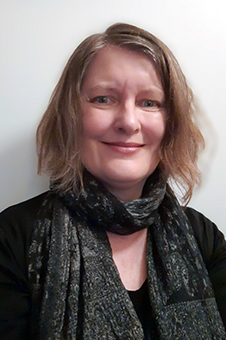
Trainee interns who took part in the study.
An Otago academic says it's time to ask tough questions after an audit revealed “concerningly low” numbers of people scanning COVID-19 QR code posters.
Five supermarkets, five churches, 10 restaurants, 10 cafes and 10 bars were randomly selected and visited by Dunedin School of Medicine Trainee Interns within an hour of their busiest times between January 20 and February 14.
Using published Ministry of Health guidance on how to display QR code posters, the final year medical students assessed how well the posters were displayed at each venue and also counted the number of people who entered the venue during a one hour period and whether or not they scanned the poster.

Associate Professor Lianne Parkin.
Associate Professor Lianne Parkin, of the Department of Preventive and Social Medicine, who initiated and supervised the audit, says while many of the venues displayed the posters appropriately, there was still room for improvement at some of the hospitality venues.
At nearly a third of venues, no visitors scanned the QR code posters.
“The absence of scanning at eight of the ten bars is particularly concerning because these are venues that are often crowded, and behaviour may be adversely affected by alcohol, so there is a higher potential for virus transmission,” Associate Professor Parkin says.
The proportions scanning at the other venues were also low; the medians were 21.5 per cent at cafes, 10.2 per cent at restaurants, 4.4 per cent at churches and 14.1 per cent at supermarkets.
“These findings are worrying for two reasons. Firstly, if a non-scanning visitor to a venue was subsequently diagnosed with COVID-19 it might take some time to identify that venue as a location of interest and that would delay contact tracing.
“Secondly, even if the venue was quickly identified, other non-scanners would not receive a digital alert through the COVID-19 Tracer app that they were a potential contact. These delays in identifying contacts could result in further cases in the community - some of which could be fatal or very serious - and, potentially, a further lockdown,” she says.
Associate Professor Parkin says people need to remember “that we are scanning to protect the people around us”.
“Although the risk of COVID-19 community transmission is very low, it is not zero – as we have seen on several occasions in the last few months. We have also seen that there can be very serious health and economic consequences for our families, friends, workmates, and wider communities whenever there is community transmission.
“So, I think we all need to ask ourselves some tough questions; 'How would I feel if contact tracing was too slow to prevent onward transmission of the virus to others around me simply because I did not take a few seconds to scan a QR code poster or sign into a venue? How would I feel if some of those people became seriously ill or died? How would I feel if we had to go into lockdown again'?”
Associate Professor Parkin initiated the study after her experiences at a concert left her worried about how QR code posters were being displayed – in that case there was no poster at the entrance to the venue and although there was one inside, it was hard to find and people were unable to scan it because it was at an awkward height and there was too much glare. A poster was later placed at the entrance, but it was attached to a sliding door which made it difficult to scan.
“If someone in the audience had had COVID-19, the consequences could have been very serious as the venue was full and the majority of the audience were older adults. And because people were unable to scan, timely contact tracing could have been difficult.
“Following this experience, and having observed barriers to scanning at other venues, I was keen to carry out a systematic audit of how well posters were being displayed at other indoor venues around Dunedin, and what proportion of visitors to those venues were scanning the posters. Our local Medical Officers of Health were also interested in these questions and we were very fortunate that an enthusiastic group of Trainee Interns, led by Aqeeda Singh, was able to undertake the work.”
Publication details
Audit of NZ COVID Tracer QR poster display and use in Dunedin
Lainne Parkin, Aqeeda Singh, Emily Seddon, Evie Hall, Frances Bridgman, Kate Saunders, Madison Hutton, Oriwia Naera, Phillipa Rolleston, Raymond Siow, Stephanie Ewen.
New Zealand Medical Journal
For more information, contact:
Associate Professor Lianne Parkin
Department of Preventive and Social Medicine
Email lianne.parkin@otago.ac.nz
Lea Jones
Communications Adviser
University of Otago
Tel +64 3 479 4969
Mob +64 21 279 4969
Email lea.jones@otago.ac.nz
Find an Otago Expert
Use our Media Expertise Database to find an Otago researcher for media comment.